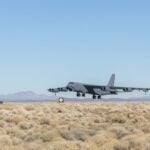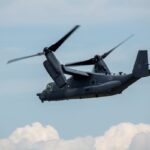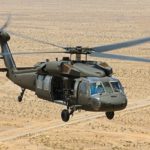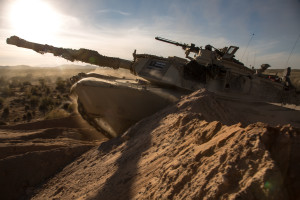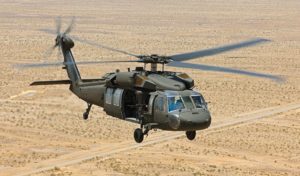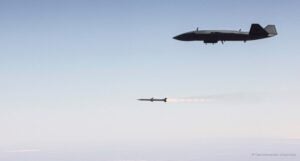USAF Munition Multi-Years. U.S. Air Force Secretary Frank Kendall says that multi-years “incentivize” industry production line investments and give companies “some assurance that they’re gonna have funding for continued acquisition by the government.” The Air Force has requested multi-year authority for the Lockheed Martin Joint Air-to-Surface Standoff Missile and the Long-Range Anti-Ship Missile and the RTX Advanced Medium Range Air-to-Air Missile in fiscal 2024. The latter munitions “are focused on the pacing challenge—China—and possibly Russia, but we’re having a lot of difficulty getting people to agree to that,” Kendall says of the multi-year authority requested by the Air Force.
In Ukraine, Drone Stacks, Not Swarms. A new report from the Center for a New American Security (CNAS) concludes that the use of drones in Ukraine represents an evolution, not a revolution, in warfare. “Drones are more effective when operated as a part of larger team of uncrewed systems,” the report said. “Swarms typically consist of a greater number of units that autonomously coordinate their behavior. The drone stacks used by both sides in the war in Ukraine have been coordinated through multiple drone operators using software-based battle networks, traditional means of communication, or commercial communications platforms. Both parties claim to be using artificial intelligence to improve the drone’s ability to hit its target, but likely its use is limited.” While Russia has cycled Orlan-10 and ZALA surveillance drones to the fight, Ukraine has had a smaller, kamikaze and ISR drone inventory, “which limits its forces’ visibility and reach behind the front lines,” the report said. “This gap may eventually close as Ukraine’s government is investing heavily in its indigenous drone industry.” Drones have also not established air superiority, nor have they been a substitute for artillery, CNAS said. “Artillery barrages far outstrip the firepower that many small drones can collectively deliver,” according to the report.
LCS-36. The future USS Kingsville (LCS-36) Independence-variant Littoral Combat Ship completed acceptance trials with the U.S. Navy in the Gulf of Mexico on Jan. 31, shipbuilder Austal USA said. The trials had the Navy’s Board of Inspection and Survey (INSURV) performing comprehensive testing on the ship’s major systems and equipment to demonstrate successful operation and mission readiness. INSURV also validated the quality of construction and compliance with service requirements. LCS-36 will be the 18th Independence-variant ship and is due to join its sister ships in the Pacific fleet after delivery. Now Austal USA said the last LCS it has under construction is the future USS Pierre (LCS 38). When LCS-38 is complete, the Independence-variant line will be closed.
MH-60R Configs. The Navy awarded Lockheed Martin a $150.6 million undefinitized modification on Feb. 2 to cover non-recurring engineering and add/delete efforts to help bring six MH-60R Seahawk helicopters from a standard Foreign Military Sales configuration to a unique configuration for Norway. The award also covers scope for production and delivery of four Embedded Global Positioning System Inertial Navigation Systems spares, production spares, field and technical service representative support, and electronic support measures in-country reprogramming hot bench. The work is expected to be finished by February 2027.
…And Taiwan JSOWs. The Navy also awarded RTX a $68 million modification exercising an option to produce and deliver 50 Joint Standoff Weapon Air-To-Ground Missiles (AGM-154 Block III C) for Taiwan. Work will mostly occur in Tucson, Ariz., with over 34 percent split between various other U.S. and U.K. locations and it is expected to be finished by March 2028. This was awarded on Jan. 31 and posted to the DoD’ Feb. 2 notification.
CVN Inactivation Office. On Feb. 2 the Navy marked the establishment of the first nuclear-powered aircraft carrier (CVN) Inactivation and Disposal Program Office (PMS 368), within Program Executive Office Aircraft Carriers (PEO CVN). The office will lead efforts to dismantle and dispose of the former USS Enterprise (CVN-65) as well as the future inactivation, dismantlement, and disposal of Nimitz-class carriers. Lessons learned from the Enterprise process will inform disposal options for the 10 Nimitz-class fleet as they gradually retire. The office is facing decades of work, with the last ship in the class, the USS George H. W. Bush (CVN-77), set to be inactivated in the mid-2060s.
…New Dismantling Standards. Program office leaders said they will help shape standards across the Navy’s nuclear enterprise that will last for decades. “The United States is the only country in the world that builds nuclear-powered, large-deck carriers, and for the first time, we’re creating a blueprint for the Navy on how to dispose of them,” program office head Capt. William B. Cleveland, said in a statement. Then-acting Assistant Secretary of the Navy for Research Development and Acquisition Jay Stefany started the process for setting up PMS-368 in August 2023. In September 2023, the Navy released it final Record-of-Decision, which selected commercial dismantlement of the carrier following various assessments, market research and reviews. This seeks to allow the Navy’s public shipyards to focus on ship maintenance rather than adding CVN-65 disposal to its list of duties. The process will have the Navy dispose of the carrier, with its radiological and other hazardous materials in about five years.
…Industry Day. PMS-368 plans to host an industry day from March 6-7 to share information with businesses on the opportunities to participate in the carrier dismantlement. Concurrently, over the next months the office “will be focused on fleshing out planning and budgeting efforts as well as recruiting and hiring new personnel for the office,’ the Navy said.
High-Speed VTOL. Textron’s Bell said on Feb. 8 that it used the high-speed test track at Holloman AFB, N.M., to demonstrate “the folding rotor, integrated propulsion and flight control technologies at representative flight speeds” of high-speed vertical take-off and landing (HSVTOL) for DARPA’s SPRINT program that seeks to develop high-speed, runway independent airlifters, Bell said. Jason Hurst, Bell’s executive vice president for engineering, said in a Bell statement that the demonstration “provides Bell with critical experience and knowledge that will inform our X-plane development for DARPA’s SPRINT program” and is “a pivotal step in the creation next generation of high-speed vertical lift aircraft for future warfighters.” DARPA chose Bell, Boeing’s Aurora Flight Sciences, Northrop Grumman, and Piasecki Aircraft Corp. to begin Phase 1 of the program last November.
ScanEagles. In the fourth quarter of last year, Iraqi Security Forces “began using its own ISR assets in support of target development and providing overwatch of ground operations,” the Pentagon Inspector General says in a new report on Operation Inherent Resolve in Iraq and Syria. The Joint Operations Center-Iraq in Baghdad “has begun using the Puma platform and ScanEagles to enhance the collection of ISR, which CJTF-OIR [Combined Joint Task Force-Operation Inherent Resolve] described as a ‘significant capability increase.’” AeroVironment, Inc. builds the RQ-20 Puma drone, and Boeing’s Insitu business makes ScanEagle.
Contact Group Meeting. Defense Secretary Lloyd Austin and Air Force Gen. CQ Brown Jr., chairman of the Joint Chiefs of Staff, will travel to Brussels next week to host an in-person meeting of the Ukraine Defense Contact Group. The 19th UDCG on Feb. 14 will once again bring together senior defense officials from around 50 nations to discuss international efforts to support Ukraine in its fight against Russia’s ongoing invasion. This will be the second consecutive UDCG meeting the U.S. will host without a new weapons aid package to announce, as the supplemental funding bill to continue security assistance efforts remains stalled in Congress. While in Brussels, Austin is also set to participate in the NATO Defense Ministerial on Feb. 15.
Cyber Command/NSA Leader. Air Force Gen. Timothy Haugh on Feb. 2 officially assumed command of U.S. Cyber Command and the National Security Agency. Haugh succeeds Army Gen. Paul Nakasone, who has held the dual-hatted role of leading both USCYBERCOM and NSA since May 2018. “I am honored to begin my role as Commander of U.S. Cyber Command, Director of the National Security Agency, and Chief of the Central Security Service,” Haugh said in a statement. “Having served in both USCYBERCOM and NSA, I have seen our workforce do incredible things on behalf of the nation, creating a unique advantage that has kept us ahead of our adversaries. I have full confidence in our ability to achieve our goals, because I know that the people of the USCYBERCOM and NSA/CSS are standing ready to tackle any challenge that comes their way.” Haugh most recently served as deputy commander of USCYBERCOM.
Radar Award. The Army has awarded SRCTec a deal worth nearly $100 million for AN/TPQ-50 exportable lightweight counter-fire radar (LCMR) systems, spares and repair parts, the company said on Feb. 5. SRCTec said the five-year deal covers upgrades for the AN/TPQ-50 radar, to include “survivability improvements from existing and emerging threats.” “The AN/TPQ-50 radar provides track-while-scan capabilities that allow for simultaneous detection and tracking of multiple threats fired from separate locations,” the company said in a statement. “The radar also provides point of origin calculation for a precise response.”
SASC Advances Noms. The Senate Armed Services Committee on Feb. 8 voted to advance several nominees for senior Pentagon civilian positions. The list includes Cara Abercrombie to be Assistant Secretary of Defense for Acquisition, Aprille Ericsson to be Assistant Secretary of Defense for Science and Technology, Ronald Keohane to be Assistant Secretary of Defense for Manpower and Reserve Affairs and Douglas Schmidt to be Director of Operational Test and Evaluation. The nominations were reported to the floor for full Senate consideration.
LDUUV Award Follow-Up. Kongsberg last Friday said its selection by the U.S. Defense Innovation Unit and U.S. Navy to rapidly deliver its HUGIN autonomous underwater vehicle (AUV) capabilities for prototype testing and demonstrating could lead to the Navy acquiring its HUGIN Endurance and Superior deepwater large displacement unmanned underwater vehicles (LDUUVs). Kongsberg Discovery, part of Norway’s Kongsberg, said it has delivered about 100 large HUGIN AUV systems globally. The 39-foot long, 47-inch diameter Endurance can operate for 15 days over a 1,200 nautical mile range, and the 22-foot long, 35-ince diameter Superior has a 70-hour endurance. Kongsberg Discovery’s operations are based in Lynnwood, Wash. DIU also awarded LDUUV contracts to Anduril Industries and Oceaneering International. Oceaneering said its Freedom AUV recently completed a five-year test and development program and began commercial operations in 2023. Freedom’s dimensions are 14.8 feet by 3.9 feet wide by 2.6 feet high and has a depth rating of 13,000 feet. The values of the two-year awards were not disclosed.
PACTS Solicitations Up. The Department of Homeland Security last week issued three solicitations for its potential $8.5 billion Program Management, Administrative, Clerical, and Technical Services (PACTS) III contract for small businesses to provide various services. The solicitations cover three functional categories for commercial services, including administrative management and general management consulting, office administrative services, and engineering services. Bids for all three categories are due by March 29.
Saudi CUAS Partnership. Fortem Technologies, whose counter-drone is in use by Ukrainian forces, is partnering with Saudi Arabia’s INTRA Defense Technology to engineer and manufacture counter-unmanned aircraft system (CUAS) solutions for that country. INTRA develops and builds autonomous unmanned systems. “Fortem Technologies has been looking for ways to venture beyond its current markets, and the Kingdom of Saudi Arabia is focusing on expanding its production of air defense systems,” Jon Gruen, Fortem’s CEO, said in a statement. Hamad Alfouzan, INTRA’s CEO, said the combination of his company’s UAS capabilities with Fortem’s C-UAS solutions will “fortify our region’s defenses comprehensively.”
Palantir, Voyager Partner. Palantir Technologies and Voyager Space are teaming to assess how they can leverage artificial intelligence and machine learning technologies to bolster national security capabilities in the commercial space domain. Voyager has expertise in solid rocket propulsion, spacecraft communications and electro-optics, and is working with Airbus to design and build a commercial space station. Palantir’s AI-based software provides analytical insights and aids decision-making. Voyager said the agreement also includes exploring the integration of Palantir’s AI, ML, and edge processing capabilities to support development, manufacture, and operations of Starlab. Space domain awareness, data fusion, and edge processing are all potential use cases to enable autonomous decisions, it said.
People News. Slingshot Aerospace has named Tim Solms, who previously worked for Microsoft and VMware Federal overseeing their respective business with the Defense Department, as CEO. Most recently, Solms led federal, state, local, and Canadian government efforts for business analytics firm Dun & Bradstreet. General Dynamics’ Bath Iron Works shipbuilding division has hired Eric Masna as vice president of supply chain and quality. Masna was VP of supply chain for Fuel Cell Energy and before that headed supply chain efforts at Triumph Aerospace. Norway’s Kongsberg has appointed Heather Armentrout as president and general manager of its activities in the U.S. She previously was with Northrop Grumman, including in government relations. Finally, the private equity firm AE Industrial Partners has promoted Chris Emerson to senior partner. Emerson will lead AEI’s new office in Washington, D.C. Emerson previously led Airbus’ U.S. Space & Defense business.
Volt Typhoon. The federal government last week issued a cybersecurity advisory warning that a People’s Republic of China state-sponsored cyber group, Volt Typhoon, has compromised the information technology networks of multiple organizations primarily in the communications, energy, transportation systems, and water and wastewater critical infrastructures in the U.S. and non-continental U.S. and its territories, including Guam. The Cybersecurity and Infrastructure Security Agency, FBI, and National Security Agency, said that “Volt Typhoon actors are pre-positioning themselves on IT networks to enable lateral movement to OT (operational technology) assets to disrupt functions.”


